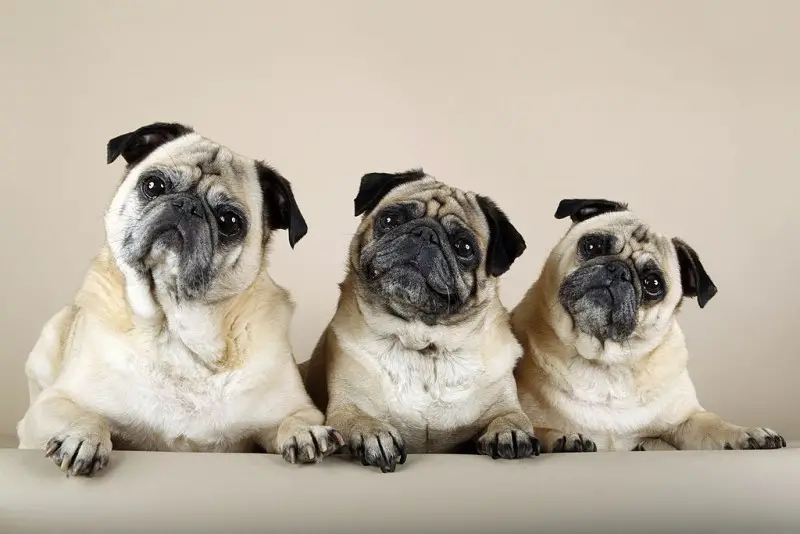The Latin phrase “multum in parvo,” which means “a lot in a little,” best describes life with a Pug dog breed. This delightful breed has grown extremely popular due to its charming disposition, playfulness, outgoing, and loving characteristics.
Pug’s great personality makes them great companions. Pug is quite naughty, but they are adaptable and sturdy. Thus, they make ideal pets for families with children. More than anything, Pug loves being the center of attention. These delightful goofballs are sure to steal hearts from children, adults, other animals, and even strangers!
These cute dog belong to the Toy group, and despite their small sizes, they are quite stocky and sturdy. They can happily live in the urban jungle or the countryside. They are not picky with people or living environments. But these dogs are indoor pets. Your Pug will prefer to snuggle on your sofa and spend the rest of the day cuddling with you. They can be a bit sensitive and stubborn. On the other hand, Pug does love to please their people, so they can be trained.
However, watch your Pug for signs of illness that they are prone to have. Pug loves food and can become lazy; thus, they may become obese. They also have unique features like their face wrinkles, and protruding eyes require special care to keep them safe and healthy.
All in all, Pugs are lively and playful canines. They require moderate physical activity to avoid weight gain. The Pug breed is also not tolerant of hot weather and prone to heatstroke. They need average maintenance for their short coat because they shed a lot. Moreover, the Pug have a bit of a drooling tendency, so expect some moderate smell levels.
Interesting Facts
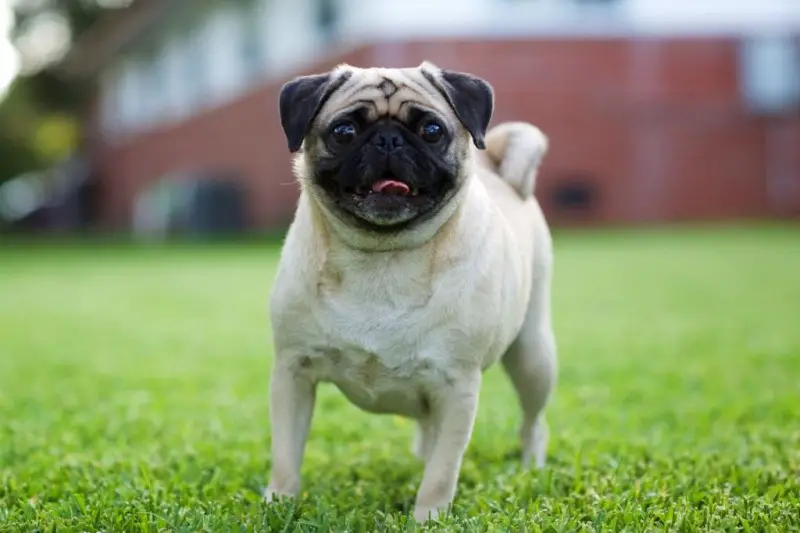
The Origin of Pug
Pugs are one of the ancient dog breeds. These cute little canines came from China, dating back to the Han Dynasty (206 BC to 200 AD). Historians consider the Pug to be a distant relative of the Tibetan Mastiff. The Pug is a treasured pet of the Emperors of China, lived luxuriously, and are even guarded by soldiers.
Chinese have bred three kinds of short-nosed canines, the Pekingese, the Lion Dog and the Lo-sze, or what is known as the ancient Pug. The “Foo Dogs” are said to be distinctive representations of the ancient Pug, and there is also evidence of Pug-like dogs in ancient Japan and Tibet.
Later on, in the 1500s and early 1600s, the first Pug was brought to Europe as the Chinese started trading with Europeans. They were first noticed with Dutch traders who called them Mopshond - a name that stuck with them even today.
Royal households in Europe fell for the charm and vibrancy of the Pug. They became favorite pets and played significant roles in the histories of the noble families. For instance, the Pug became the official dog of the House of Orange after one saved the life of William, the crown prince of the Orange. Allegedly, his pet warned him of the approaching Spaniards in 1572. Thus, when they went to England in 1688 with his wife, they brought along their Pugs with them.
Black Pugs were also known to exist in the 1700s. William Hogarth, a famous artist and a Pug enthusiast portrayed a black Pug in many of his paintings. More so, the Pug was also featured by the artist Goya in his works in 1785.
As the Pug breed's popularity spread out in Europe, it was recognized through various names. They were called Dagullo in Spain, Caganlino in Italy, and Mops in Germany.
Royalties had Pugs as their beloved pets too. Marie Antoinette and Josephine Bonaparte both had Pugs as pets, and their pets played essential roles in shaping their family history.
Pug became a standard breed in the 1800s. Two lines became dominant in England. One was referred to the Morrison line and was founded upon the royal canines of Queen Charlotte. Lord and Lady Willoughby d’Eresby founded the other line. They had dogs imported from Hungary and Russia.
The first Pug exhibition was in 1861, and the studbook started in 1871, with 66 pups in the first volume.
In the meantime, Pug continued to be bred by the royal families in China. When the Chinese Imperial Palace was overrun by the British in 1860, they found several Pugs and brought back some of the canines back to England.
Two “pure” Chinese Pugs - Moss and Lamb were brought to England and produced Click. He was an outstanding Pug and bred many times with the Morrison and Willoughby lines. Likewise, Click has the credit for making Pugs the wonderful breed they are today.
During the Victorian Era, the Pug breed was very popular and they made them fascinating subjects in paintings, figurines, and postcards. The Pug was often shown wearing wide collars or large bows around their necks. Queen Victoria owned several Pugs and bred them. She liked the apricot-fawn colored Pug, while Lady Brassey preferred the fashionable black Pug.
In the US, the Pug was recognized as a breed by the American Keen Club in 1885. They first arrived in the country after the Civil War and became very popular. At the turn of the century, the Pug popularity waned but regained it with the dedication of a few breeders. The Pug Dog Club of American was then founded in 1931.
The Pug Temperament
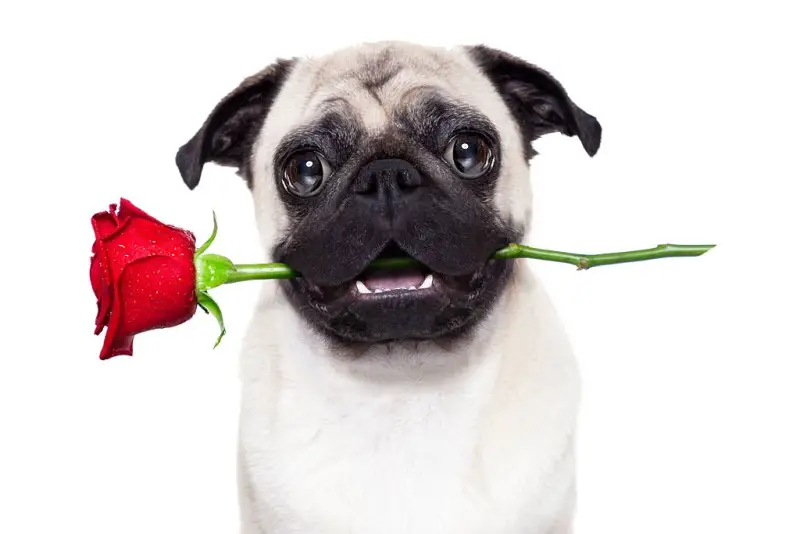
The Pug is the largest dog in the Lap dog or Toy group category. They are bred to be companions, and they excel at this role. You cannot expect a Pug to guard, retrieve, or hunt. The Pug tends to be sedentary pets who love affection and prefer to sit contentedly on your lap. These dogs will be miserable if you ignore their full-pledged devotion to you.
But while they love to cuddle on your lap, the Pug is not a stick-in-the-mud type of dog. On the contrary, they are comical, playful, and love to live it up to delight their humans with their silly antics.
Although they are small, the Pug is a sturdy breed that will not be injured easily by kids. Pugs love kids and the attention they get around little ones, but they are not up to play fetch or chase. Early training and socialization will make them get along well with other pets like cats, rabbits, and other canines. Pug breeds are brilliant dogs, and they need willful humans that can stand as their pack leaders. Don’t let these dogs’ charm get on you while you train them, they can be stubborn, and they may take advantage of you.
When choosing a Pug puppy with excellent temperament, keep in mind that there are several factors to consider. A dog’s characteristics are affected by their heredity, socialization, and training. Puppies with amiable temperaments are playful and curious. They are willing to approach people and be held by them. Pick one of the well-balanced Pugs puppy from the litter. A Pug that shies away from humans or is beating his litter-mates is not the best choice.
Ideally, meeting at least one of the Pug parents will confirm the temperament of the dogs in the litter. If available, check out siblings and relatives of the parents to help you evaluate the personalities of the puppies when they grow up.
Pug Health Problems
Generally, Pugs are a healthy and sturdy breed. However, like all other dog breeds, they are predisposed to specific health issues. These diseases are common in the breed, but it does not mean that all Pugs will have these conditions. Owners or would-be owners must be aware of the signs so that you can provide immediate veterinary care for your pet.
It is also advisable to find a reliable breeder if you will be buying a Pug puppy. They can provide you with health clearances of the parents to guarantee that they are healthy and tested clear for health conditions. For Pugs, the clearances are likely to be issued by the Orthopedic Foundation for Animals for hip dysplasia, elbow dysplasia, and hypothyroidism. Additionally, the Canine Eye Registry Foundation will also release a certification that the canine’s eyes are healthy.
The most common health issues that you should look out for in Pug dogs include the following:
Pug Dog Encephalitis (PDE) - this fatal inflammatory brain condition is unique to the Pug breed. At present, there is no test to determine the risk of a dog, and there is also no cure for this condition. The diagnosis of Pug dog encephalitis PDE is only conducted by testing the dog’s brain tissues after they die. This condition affects younger dogs and causes seizures, blindness, falling into a coma and death. Symptoms can happen in a few days or weeks. PDE seems to have a genetic component; thus, several organizations are sponsoring research to know more about this unique condition.
Cheyletiella Dermatitis - this skin condition is commonly known as the Walking Dandruff. It is caused by tiny mites that resemble dandruff on their coat. It can appear as heavy dandruff in the middle of your pet’s back. Contact your veterinarian if your Pug has this condition as it is contagious, and other pets in the house may also need treatment.
Epilepsy - another health condition that causes seizures in Pug is idiopathic epilepsy. Your pet may have seizures for no apparent reason, and when they do, inform your veterinarian to determine the appropriate treatment plan.
Eye Problems - the Pug’s large and protruding eyes make them prone to various eye problems. Some Pug eye conditions to look out for include the following:
- Proptosis - when the eyeball is dislodged from the socket and the eyelid clamps behind it;
- Progressive retinal atrophy - a degenerative disease that usually leads to blindness;
- Distichiasis - the abnormal eyelash growth on the eye’s margin, it results in the rubbing of the eyelash against the eye);
- Entropion - rolling inward of the lower lid, causing the hair of the lid to rub against the eye.
Yeast Infection - a Pug with yeast infection will be smelly and has blackened and thick skin. It usually affects the feet, armpits, neck, inside of the ears, and groin. Ask your veterinarian for medications to clear up this infection.
Hip Dysplasia - this illness affects both large and small dog breeds including the Pug. Several factors contribute to the deformity of the dog’s hip joint. It includes diet, environment, and genetics. With proper veterinary care and attention, most affected canines can lead normal, active, and healthy lives despite being affected.
Allergies - Pug dogs are also prone to various forms of allergies, from contact to food allergies. Some signs of allergies include constant paw licking and face rubbing. Make sure to have your Pug checked by the veterinarian for treatment.
Legg-Perthes Disease - this condition also affects the hip joint of canines. Most toy breeds, including the Pug, are predisposed to have this disease. A dog with this condition usually has a decreased blood supply in the femur. Eventually, the head of the femur connected to the pelvis starts to disintegrate. Early signs of this illness include limping and atrophy of the leg muscles. It can happen while the puppies are between four to six months. It can be corrected with surgery to cut the diseased bone, and it is no longer connected to the pelvis. The canine will grow scar tissue that will create a false joint, and they will continue living a pain-free life.
Patellar Luxation - this condition pertains to the dislocation of the kneecap. A Pug with this illness experiences a crippling pain when the knee joint slides out of place. On the other hand, some dogs can normally live despite having this condition.
Sensitivity to Vaccines - there are also cases when a Pug develops sensitivity to routine vaccinations. The effects include anything from facial swelling, hives, lethargy, and soreness. Although rare, pups that are sensitive to vaccines can have complications or die. Thus, watch out for signs of sensitivity on your Pug after they are vaccinated.
Hemi-Vertebrae - this condition is common with short-nose breeds like Bulldogs and Pugs. They have deformed vertebrae, but even when affected, most pups with this condition can live a healthy and active life. In some cases, they display uncoordinated and weak gait in their fourth to the sixth month. It may progressively worsen, and some become paralyzed. Surgery can help treat Pug with this condition.
Colors
Pug breeds are typically fawn-colored or black. Their fawn color has various tints, such as silver or apricot. They all have a flat, short black muzzle. Pug has a short double coat that is smooth and soft to touch. However, they shed like crazy, especially during hot summer months. They are not hypoallergenic and will surely leave hair everywhere around your home. Wiser Pug owners simply adjust their wardrobe by opting for light-colored clothing to hide those dog hairs.
Rescue Groups for Pug
There are instances when people purchase Pugs without a clear notion of what goes into owning one. These poor pooches end up in foster homes and are waiting for you to take them to their forever home. There are several rescue centers around the country; some are not yet listed. If you don’t see a center listed in your area, you can look up the Pug Dog Club of America, the national breed club, or the local pug clubs. They can point you towards a rescue center where you can find your Pug-mate.
Grooming Your Pug Dogs
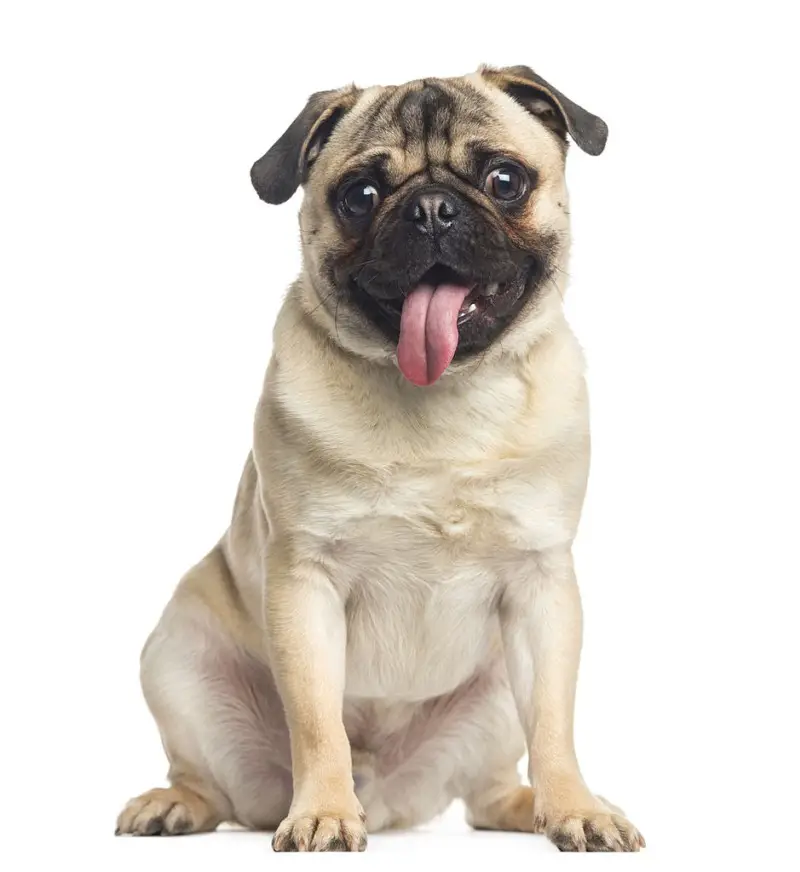
The Pug’s short and smooth coat requires regular brushing. A monthly bath is sufficient to keep their skin in good condition and to keep shedding at a minimum. On the other hand, some pet parents bathe their Pug more frequently. This dog’s compact size makes it easy and handy: you can easily wash them in the kitchen sink for a quick bath.
Pug need nail trimming because they don’t wear down their nails as much as outdoor dog breeds. Moreover, it is ideal for cleaning their ears every few weeks. You can also monitor potential yeast infection by checking out their ears regularly.
The Pug’s face wrinkles require special attention. It collects a lot of junk and grime as they spend lots of time with their faces in the ground, dirt, and food bowls. Dirt and food particles can get trapped in these folds; thus, it needs cleaning at least two times a week. You may use mild hydrogen peroxide and warm water solution to clean the inner folds of their wrinkles gently.
After bathing, it is also crucial to completely dry the Pug facial wrinkles. Wipe the folds in to prevent infections from developing. Some owners use cotton balls or Q-tips to clean their pooch’s face thoroughly.
Similarly, the Pug's bulging eyes also require special attention. Their protruding eyes are vulnerable to irritation and injury from chemicals and pet soaps.
And as with most small breeds, Pugs are also susceptible to gum diseases. Thus, they need regular brushing using a soft, small toothbrush and dog toothpaste. You can train your Pug to become accustomed to brushing and examining when it is still a puppy. Likewise, hold their paws often and look inside their mouth. Grooming should be a positive experience with praise and rewards. When they grow up into adult Pugs, they will behave well during veterinary exams and handling.
Don’t forget to check your Pug for rashes, sores, and any signs of infection as you groom them. Look out for any tenderness, redness, or inflammation on the skin, eyes, nose, mouth, and feet. Their eyes should be clear and free from discharge or redness. Doing these checks frequently will help you spot early signs of potential health problems that are common in Pugs.
Exercise and Training
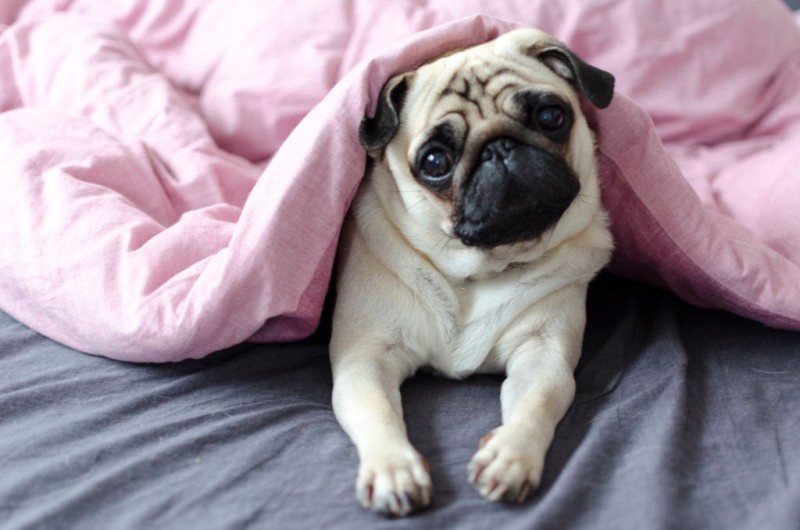
Although they belong to the Toy Group and are but a small breed, Pugs are strong dogs with short, straight limbs. They require quick daily walks to keep them healthy. While taking them out for a walk, you must observe that they stay on heel beside or behind you as you hold the leash.
Pugs also love energetic games and will keep them fit if you give them regular exercise. However, be careful not to overdo any physical activities with your Pug as they are prone to wheezing and overheating. The Pug breed also snores a lot and is known to have breathing problems.
And similar to other dogs, early socialization training is crucial in Pugs. They need exposure to different people, pets, sounds, sights, and experiences while they are young. With socialization, your Pug will grow up to become well-rounded adult dogs.
For starters, you may enroll your Pug pup in a kindergarten class. Additionally, you can invite guests over to your home, take them to busy parks and stores, and stroll them in the neighborhood to meet neighbors. It will help polish their social skills and make them even more amiable to people and pets around them.
Feeding Your Pug
Pugs primarily love human attention, but their second love is food! These dogs love to eat, and they do eat a lot. Their passion for food combined with their small built makes them prone to becoming overweight. As a Pug parent, you need to restrain them to avoid dog obesity. Do not overindulge them with food and make sure that you give them appropriate feeding portions. Moreover, be sure to limit treats and encourage them to exercise.
The recommended daily feeding for Pugs is half cup to one cup of high-quality dry food per day. It should be divided into two meals. Keep in mind that how much they eat depends on their size, build, age, activity level, and metabolism. Just like humans, dogs’ need for food is very individual. Therefore, a highly active canine will need more food compared to a couch potato pooch. Moreover, high-quality food will go forward to nourishing your dog. CHECK OUR GUIDE AND LIST OF DOG FOOD FOR PUGS (ADULT & PUPPY)
FAQS About Pugs
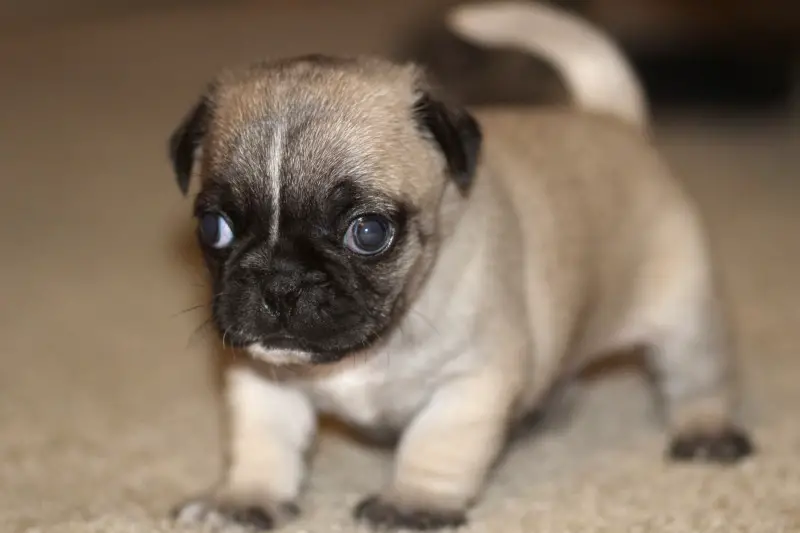
How long Do Pugs Live?
On average, a Pug can have a lifespan of 12 to 15 years. Most of them fall on the lower end of this range. The average female life span is about 13.2 years, while the males have a little less at 12.8 years on average. Consequently, you will also find Pugs that lived well into their teens, some reaching the age of 17 years.
Are Pugs Hypoallergenic?
Although there are no 100% hypoallergenic dogs breeds, it is possible to own a less-hypoallergenic canine. Unfortunately, though, Pugs are not hypoallergenic. Despite their short coat, Pug shed a lot and leaves a lot of dander.
Are Pugs Smart and Easy to Train?
The Pug breed is smart, observant, and quick learners. For instance, they can easily make connections to what you are trying to teach them. On the bright side, these traits should make them easy to train. However, Pugs can be quite stubborn and extra mischievous. They will sometimes ignore you when called. Thus, expect your training session to be challenging and have some additional supply of patience on your part. If you persevere, your efforts will all be worth it.
How many puppies do Pugs have?
The average litter of a Pug is around two to six puppies.
Does the Pug Drool?
The Pug is a delightful creature with thick lips and folds on their faces. A liquid can easily puddle up in the corners of their mouth. But contrary to what most people think, Pug is not heavy droolers. They might occasionally do, thus check your slippers first before putting them on.
How much does a Pug Bark?
The Pug breed tends to be quiet, making some people think that they do not bark. But they do bark sometimes, but not the obnoxious kind. They have this kind of bark that resembles a sound made by a yodeling singer, or they yip when they are excited.
How Much is a Pug?
Pugs are priced according to their lineage. If you get one from a superior pedigree, the prices can range from $1900 to $6000. The median price is around $1022, but you can always adopt a Pug because there are lots of them in rescue centers too.
Conclusion
Pugs are very loving, and they have that human-like expression that quickly endears them to their owners. If you intend to welcome a Pug into your family, be willing to accept them as you would a newborn child. These dogs need your care and attention, and they will return it a thousand fold. They have a massive personality than all of the household members combined. Pugs will bring your home lots of laughter, loyalty, affection, and love.
MORE ABOUT PUGS:
